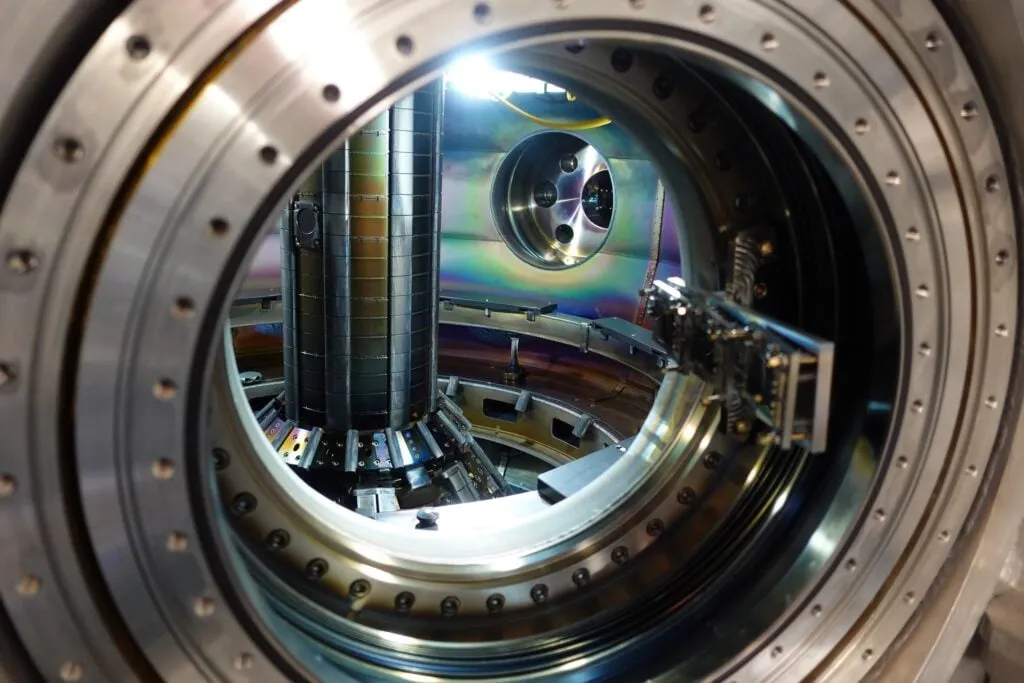US and UK join forces for $52M ST40 Upgrade
By Lizzie Mushangwe

The ST40 spherical tokamak. ©Tokamak Energy
Tokamak Energy, in partnership with the US Department of Energy (DOE) and the UK’s Department for Energy Security and Net Zero (DESNZ), has announced a $52 million upgrade to its record-breaking ST40 spherical tokamak. Revealed on December 5th, the upgrade will focus on integrating lithium as a plasma-facing material and commence in 2025. This initiative underscores the importance of international collaboration in advancing fusion science.
So, what has happened and why is it significant?
What have they done?
Tokamak Energy has partnered with the US Department of Energy (DOE) and the UK’s Department for Energy Security and Net Zero (DESNZ) to embark on a $52 million upgrade to its ST40 spherical tokamak.
This collaborative effort will focus on coating the inner walls of the ST40 device with lithium, a plasma-facing material that has the potential to enhance plasma performance by reducing impurities and improving energy confinement.
Building on foundational research by Princeton Plasma Physics Laboratory (PPPL) and Oak Ridge National Laboratory (ORNL), the ST40 tokamak will become a robust testing ground for one of fusion energy’s most challenging aspects—managing the extreme heat and particle flux within a fusion machine.
Why Is It Impressive?
This collaboration reinforces the US-UK fusion strategic partnership announced in 2023, aiming to foster shared access to cutting-edge facilities and expand joint research efforts. Warrick Matthews, CEO of Tokamak Energy, emphasised the importance of this endeavour: “This program will advance fusion science and technology for spherical tokamaks and the industry more broadly, in pursuit of a common goal to deliver fusion power.”
The ST40 is no stranger to records—it has already achieved plasma temperatures “six times hotter than the core of the sun,” a feat critical to sustaining nuclear fusion. This upgrade will further solidify its position as the longest-operating private fusion tokamak and the best-performing prototype device in the private sector.
Why is it important?
The ST40 upgrade directly addresses one of fusion energy’s most significant challenges: the interaction between plasma and tokamak walls. By introducing lithium, the project not only tests a material capable of handling these extreme conditions but also lays the groundwork for scalable solutions in future (spherical) tokamak devices.
Tokamak Energy has long recognised lithium’s vital role in fusion power plants, particularly for plasma-facing components (PFCs) and the breeding blankets that capture energy and ‘breed’ tritium fuel. As part of the ST40 upgrade, Tokamak Energy team plan to “coat all plasma facing components, including the central column and divertors, with solid lithium using the ‘lithium evaporation’ technique.”
Research by Princeton Plasma Physics Laboratory (PPPL) and other institutions has shown that lithium plasma-facing components (PFCs) offer transformative benefits for fusion performance. Specifically, lithium coatings can absorb escaping particles from the plasma, maintain elevated temperatures at the plasma edge, and boost energy confinement and edge stability.
PPPL Director Steven Cowley emphasised the significance saying, “PPPL pioneered the use of lithium coatings in fusion back in the 90s. We’ve since refined our understanding of the radical confinement improvements these coatings can enable, and we’re excited to see this expertise leveraged by and advanced in collaboration with the private fusion industry.”
This initiative also highlights the strength of the US-UK fusion partnership. Aligned with the DOE’s Bold Decadal Vision for Commercial Fusion Energy and the UK’s Fusion Strategy, the collaboration demonstrates how international alliances can drive fusion energy from experimental research towards a viable energy source.
Beyond its scientific value, the upgrade will drive economic benefits by creating high-quality jobs, strengthening the fusion energy supply chain, and fostering innovation in both nations. Dr. Geraldine Richmond, DOE Under Secretary for Science and Innovation, remarked: “This represents a huge leverage opportunity for advancing fusion science and technology. These new investments will strengthen our partnerships with the private sector and our international allies. Each partner stands to gain significantly more than the funds committed.”
What’s next?
Starting in 2025, the upgrade program will implement lithium coatings and conduct a series of experiments to assess their impact on plasma performance. These experiments aim to refine the understanding of energy confinement and material resilience—two critical factors for building scalable and economically viable fusion devices.
The outcomes of this initiative will influence the design and development of future fusion pilot plants, with the ST40 serving as a model for compact and cost-effective fusion devices.
Looking ahead, the evenly-divided collaboration between Tokamak Energy, DOE, and DESNZ could pave the way for even more international public-private partnerships.
As Jean Paul Allain, the DOE’s Office of Science Associate Director for Fusion Energy Sciences, noted: “It’s these publicly supported scientists, collaborating with their colleagues at private facilities, who drive the major advances needed in this field to support a competitive US fusion power industry.”
